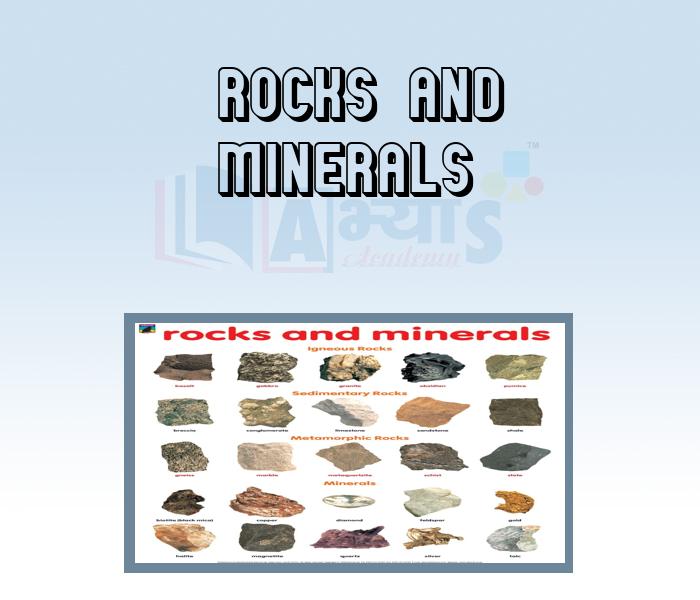Rocks And Minerals









Rocks And Minerals
Rocks And Soils:
Rock (Minerals): The materials of the crust or líthosphere are generally called a rock. These rocks consist of various minerals. Based on their composition, rocks can be classified into - silicate rocks, carbonate rocks,sulphide rocks etc.
Types Of Rocks: Based on the mode of their formation rocks are divided into three broad categories, which are explained as under:
A. Igneous Rocks: Igneous rocks are formed from a molten or partly molten material called magma. Magma forms deep underground when rock that was once solid melts. Overlying rock presses down on the magma, and the less dense magma rises through cracks in the rock. As magma moves upward, it cools and solidifies. Magma that solidifies underground usually_cools slowly, allowing large crystals to form. Magma that reaches Earth's surface is called lava. Lava loses heat to the atmosphere or ocean very quickly and, therefore, solidifies very rapidly, forming very small crystals or glass. When lava erupts at the surface again and again, it can form mountains called volcanoes.
Igneous rocks commonly contain the minerals feldspar, quartz, mica, pyroxene, amphibole, and olivine. Igneous rocks are named according to the minerals they contain. The igneous rocks can be of two types, if the presence of acid forming radical, silicon, is taken as the basis:
I. Acid Rocks: These are chataeterised by high content of silica-up to 80 per cent, while the rest is divided among aluminium, alkalis, magnesium, sodium, potassium, iron oxide, and lime.
II. Basic Rocks: These rocks are poor in silica (about 40 per cent). Magnesia content is up to 40 percent and the remaining 40 per cent is spread over iron oxide, lime, aluminium, alkalis, potassium etc. Due to low silica content, the parent oaterial of such rocks cools slowly and thus, flows and spreads far away.
Coarse-Graincd Rocks are the revalt of slow cooling of the magma deep inside the earth, eg. granite.
Fine Grained Rocks are the resuzlt of rapid cooling of the magma near the earth's surface, e.g. basalt.
Glassy Rocks are a result of ertremely rapid cooling of the magma,
B. Sedimentary Rocks: Sedimentary rocks form when loose sediments, or rock fragments, harden. Geologists place sedimentary rocks into three broad categories:
(1) Mechanically formed rocks or clastic rocks, which form from clasts, or broken fragments, of pre-existing rocks and minerals;
(2) Chemical Rocks, which form when minerals precipitate, or solidify, from a solution, usually seawater or lake water; and
(3) Organic Rocks, which form from accumulation of animal and plant remains.Coal is another common organic rock. Coal comes from the carbon compounds of plants growing in swampy environments. Plant material falling into the muck at the bottom of the swamp is protected from decay. Burial and compaction of the accumulating plant material can produce coal, an important fuel in many parts of the world. Coal deposits frequently contain plant fossils.
C. Metamorphic Rock : Metamorphic rock forms when pre-existing rock undergoes mineralogical and structural changes resulting from high temperatures and pressures. These changes occur in the rock while it remains salid (without melting). In a metamorphic rock, one mineral assemblage changes to another when its atoms move about in the solid state and recombine to form new minerals. This change from one mineral assemblage to another is called metamorphism. As temperature and pressure increase, the rock gaiins energy. This fuels the chemical reactions that cause metamorphism.Thin plate-shaped minerals, such as mica, align perpendicular to the direction of maximum pressure, giving rise to a layering in the rock that is known as foliation. Compositional layering, or bands of different minerals, can also occur and cause foliation. At low pressure, foliation forms fine, thin layers,in the rock slate. At medium pressure, foliation becomes coarser, forming schist. At high pressure foliation is very coarse, forming gneiss. Commonly, the layering is folded in complex, wavy patterns from the pressure.
Students / Parents Reviews [20]
Abhyas academy is great place to learn. I have learnt a lot here they have finished my fear of not answering.It has created a habit of self studying in me.The teachers here are very supportive and helpful. Earlier my maths and science was good but now it has been much better than before.

Barkha Arora
10thIt has a great methodology. Students here can get analysis to their test quickly.We can learn easily through PPTs and the testing methods are good. We know that where we have to practice

Barkha Arora
10thMy experience was very good with Abhyas academy. I am studying here from 6th class and I am satisfied by its results in my life. I improved a lot here ahead of school syllabus.

Ayan Ghosh
8thAbhyas institute is one of the best coaching institute in the vicinity of Ambala cantt.The institute provides good and quality education to the students.The teachers are well experienced and are very helpful in solving the problems. The major advantages of the institute is extra classes for weak...

Shreya Shrivastava
8thA marvelous experience with Abhyas. I am glad to share that my ward has achieved more than enough at the Ambala ABHYAS centre. Years have passed on and more and more he has gained. May the centre flourish and develop day by day by the grace of God.

Archit Segal
7thMy experience with Abhyas Academy has been very good. When I was not in Abhyas whenever teacher ask questions I could not speak it confidently but when I came in Abhyas, my speaking skills developed and now I am the first one to give the answer of teachers question.

Upmanyu Sharma
7thAbhyas institute is one of the best coaching institute in the vicinity of Ambala Cantt area. The teachers of the institute are well experienced and very helpful in solving the problems of the students.The good thing of the institute is that it is providing extra classes for the students who are w...

Aman Kumar Shrivastava
10thIt was good as the experience because as we had come here we had been improved in a such envirnment created here.Extra is taught which is beneficial for future.

Eshan Arora
8thAbhyas is an institute of high repute. Yogansh has taken admission last year. It creates abilities in child to prepare for competitive exams. Students are motivated by living prizes on basis of performance in Abhyas exams. He is satisfied with institute.

Yogansh Nyasi
7thIn terms of methodology I want to say that institute provides expert guidence and results oriented monitering supplements by requsite study material along with regular tests which help the students to improve their education skills.The techniques of providing education helps the students to asses...

Aman Kumar Shrivastava
10thMy experience with Abhyas is very good. I have learnt many things here like vedic maths and reasoning also. Teachers here first take our doubts and then there are assignments to verify our weak points.

Shivam Rana
7thMy experience with Abhyas academy is very good. I did not think that my every subject coming here will be so strong. The main thing is that the online tests had made me learn here more things.

Hiya Gupta
8thUsually we see institutes offering objective based learning which usually causes a lag behind in subjective examinations which is the pattern followed by schools. I think it is really a work of planning to make us students grab the advantages of modes of examination, Objective Subjective and Onli...

Anika Saxena
8thI have spent a wonderful time in Abhyas academy. It has made my reasoning more apt, English more stronger and Maths an interesting subject for me. It has given me a habbit of self studying

Yatharthi Sharma
10thThe experience was nice. I studied here for three years and saw a tremendous change in myself. I started liking subjects like English and SST which earlier I ran from. Extra knowledge gave me confidence to overcome competitive exams. One of the best institutes for secondary education.

Aman Kumar Shrivastava
10thWhen I have not joined Abhyas Academy, my skills of solving maths problems were not clear. But, after joining it, my skills have been developed and my concepts of science and SST are very well. I also came to know about other subjects such as vedic maths and reasoning.

Sharandeep Singh
7thAbhyas Methodology is very good. It is based on according to student and each child manages accordingly to its properly. Methodology has improved the abilities of students to shine them in future.

Manish Kumar
10thBeing a parent, I saw my daughter improvement in her studies by seeing a good result in all day to day compititive exam TMO, NSO, IEO etc and as well as studies. I have got a fruitful result from my daughter.

Prisha Gupta
8thAbhyas is a complete education Institute. Here extreme care is taken by teacher with the help of regular exam. Extra classes also conducted by the institute, if the student is weak.

Om Umang
10thMy experience with Abhyas academy is very nice or it can be said wonderful. I have been studying here from seven class. I have been completing my journey of three years. I am tinking that I should join Abhyas Academy in tenth class as I am seeing much improvement in Maths and English
